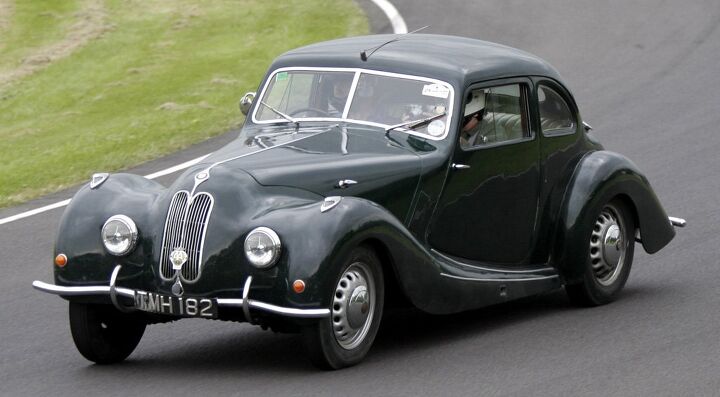The Ultimate Living Dinosaur: Bristol Coupes Built On Same Platform Since 1947

If TTAC were UK based, we’d probably have indulged in a Bristol Appreciation Week instead of Panthers. These remarkable coupes have been built on the same 114″ wheelbase chassis since the first Bristol 400 saw the light of day in 1947. Ok, I haven’t forgotten about Morgan. But the Morgan is a bit more self-conscious in its perpetuality. The Bristol’s styling has evolved a bit, although that seems to have ended in about, say 1978 or so? The NY Times has a nice article pointing out that Bristol sales are up, and never dropped in the current Great Recession. The very affluent who want a “bespoke” coupe hand built in traditional style seem to be able to manage the starting price of 142k pounds sterling. Oh, and there’s a real living breathing dinosaur under the hood too, and it’s American to boot.
Strictly speaking, the Bristol’s underpinnings are even older than 1947 (400 above). Bristol based their entry into the automotive world on pre-war BMWs. The frame came from the 326, and the 2 Litre six from the 328. And the grille gives that away, all too obviously. But fear not, Bristol paid a license to replicate the Bimmers.
But the current Bristol Blenheim can’t hide that obvious thirties configuration: super long hood with almost no front overhang, and rear wheels far forward, as well as a narrow track.
That long front fender hides what used to be carried in the open on classic cars: the spare. Now it’s only on one side; the other has access to the battery and fuse box. Leaves the trunk unencumbered, and with plenty of room for the golf clubs.
Needless to say, the interior is done in the most traditional of English style and taste, with only the finest appointments. And under that long hood: the old Chrysler 5.9 L/360 CID V8, which was replaced by the Hemi years ago hereabouts. Where Bristol gets them new is not disclosed. Maybe they bought a batch of the last ones to be made. At the small rate Bristol builds cars, they might last a while; decades even.
Here’s Robert Farago’s review of a “rebuilt” elderly Blenheim. But if you read it, make sure you also read the comments too, to get a more complete picture of the Blenheim.

More by Paul Niedermeyer
Latest Car Reviews
Read moreLatest Product Reviews
Read moreRecent Comments
- MaintenanceCosts Most of the article after the blockquote is Posky laboring mightily to somehow blame this clearly anticompetitive and oligopolistic conduct on the big bad government.I look forward to some of the usual commenters explaining to us that, actually, the oil industry is a cuddly teddy bear and the real villain is people trying to sell us cars that don't use oil.
- Bd2 A modest price bump for one of the better if not the best vehicle in it's class. And it's a very good deal still considering the Front wheel drive competition over at Lexus to name one. These Genesis vehicles are more like BMWs of the 90s but with better styling.
- Dave M. What???? Big business taking advantage of us? I thought it was all Biden's fault!?!
- OA5599 Now if we could only get Toyota to change BZ4X...
- FreedMike You mean the petroleum market is manipulated and doesn't respond to normal supply/demand? No way. Can't be. This, folks, is why electrification is important - the only reason why the petroleum industry gets away with this is because they were the only game in town for over a century. That has GOT to change or we'll keep getting ripped off.





































Comments
Join the conversation
Had a 360 and 318 MOPAR truck and car engines in several cars in the 70sthey were similar but not the same. Truck motors had 4 bolt mians, forged cranks that were (in some cases) chemical hardened (a bath of cyanide salts) that incresed surface hardness for bearing life BUT reduced the detrimental effects on toughness and therefore logevity. THe truck 318 was aboused in a 3/4 ton pick up for 390K mile the 360 truck motor in a power wagen for over 450 k miles. Loved them The 318 car engine gutted itselfpassing a truck on the I 10 outside Cucamonga. THAT was exciting. I was doing 70 when the parts started to come through the hood. The 360 made it tio about 170K miles in a charger. then the flywheel disintigrated. The truck motors were far superior. The jensen used the 440 for most of thier life.
I have a Bristol 411 Series 3 for sale in San Francisco if anyone is interested. Contact me at richard@richardgray.org